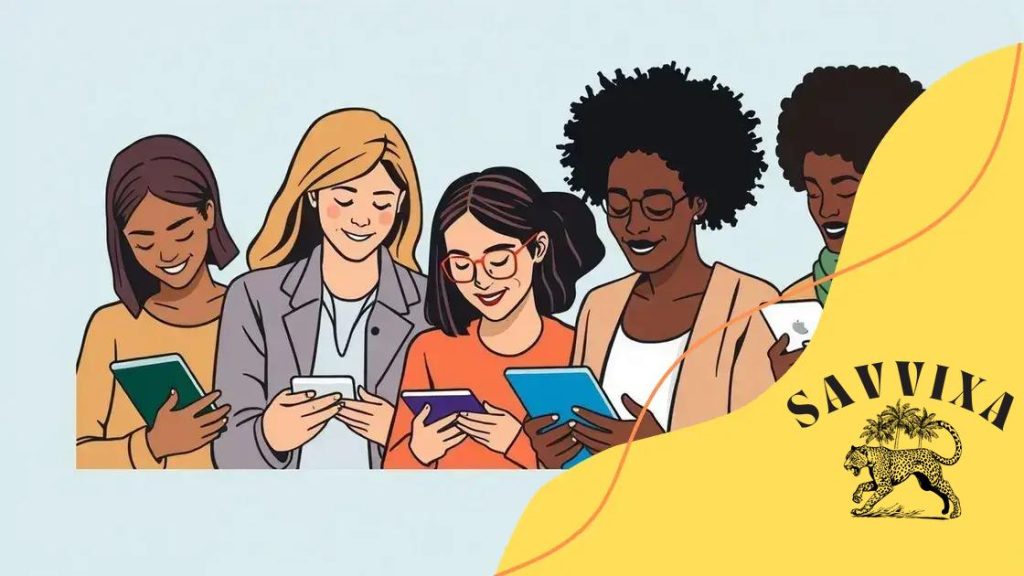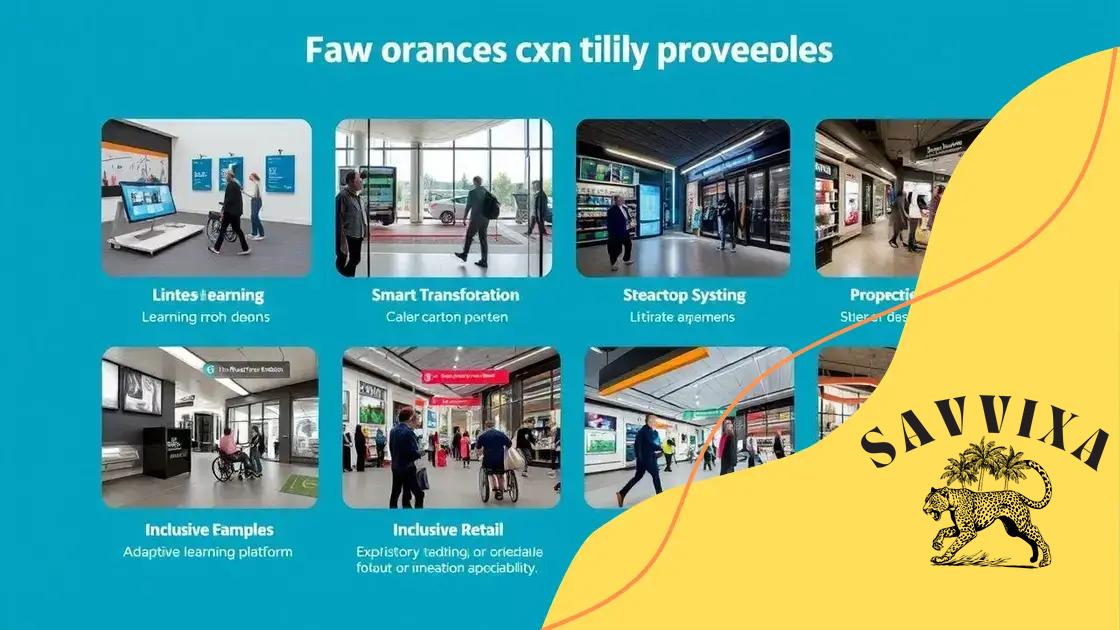Technology improving benefits accessibility for all

Technology improving benefits accessibility enhances inclusivity by providing innovative tools, addressing challenges in implementation, and leveraging future trends to create better solutions for individuals with disabilities.
Technology improving benefits accessibility is reshaping how we engage with resources and services. Have you ever wondered how it affects your daily life or opportunities? Let’s dive into this transformative topic.
Understanding technology’s role in accessibility
Understanding technology’s role in accessibility is crucial for fostering an inclusive society. This exploration reveals how innovations can bridge gaps and offer equal opportunities.
Key Technologies Enhancing Accessibility
Many technologies are specifically designed to enhance accessibility. They empower individuals with disabilities by providing tools that assist in daily activities. Examples of such technologies include:
- Screen readers: These tools help visually impaired users navigate websites and documents by converting text to speech.
- Voice recognition: This technology allows users to control devices and perform tasks using their voice, making interactions seamless.
- Accessible websites: Websites designed with accessibility in mind ensure that everyone can access information easily.
As we delve deeper, it’s clear that technology plays a pivotal role in creating environments where everyone can thrive. For instance, apps that cater to the hearing impaired, offering real-time captions during conversations, represent one significant leap. Assistive technologies like these not only enhance user experience but also foster independence.
Innovative Solutions in Action
Currently, numerous solutions are being implemented across various sectors. For example, in education, institutions are using adaptive learning technologies to cater to different learning styles. These tools help students with disabilities access the same quality of education as their peers.
Moreover, public spaces are increasingly adopting smart technologies that enable better navigation for those with mobility challenges. These innovations are a part of a larger movement toward inclusivity where technology enables everyone to engage fully.
As emerging technologies continue to evolve, we can expect even greater advancements in accessibility. Understanding how these tools work and their potential impacts will shape future developments in this vital area.
Innovative tools enhancing accessibility
Innovative tools are playing a vital role in enhancing accessibility for individuals with disabilities. These tools are designed to remove barriers, making everyday activities easier and more inclusive.
Types of Innovative Tools
There are several types of tools that stand out in their effectiveness. They include:
- Mobile apps: Applications like speech-to-text and text-to-speech provide immediate assistance in communication.
- Hearing aids: Modern hearing aids are equipped with smart technology, connecting to phones and improving sound quality.
- Adaptive software: Software that customizes user interfaces according to individual needs greatly enhances usability.
As these technologies evolve, many people are experiencing increased independence. For instance, smart home devices enable users to control their environment easily through voice commands. Wearable technology also enhances accessibility, allowing users to receive notifications and alerts without needing to reach for their devices.
Examples of Success
Many organizations are successfully implementing these tools in various settings. For example, schools are utilizing tools that help students with learning disabilities access curriculum materials effectively. In public transport, accessible navigation apps guide individuals with mobility challenges, ensuring they reach their destinations safely.
These innovations are not just theoretical; they are making a significant difference in lives around the world. As the demand for accessible solutions grows, we can expect to see even more creative and functional products developed to meet these needs.
Real-world examples of improved benefits

Real-world examples of improved benefits through technology showcase how far we’ve come in making systems more accessible. Many organizations and businesses are harnessing technology to enhance the experiences of individuals with disabilities.
Case Studies in Accessibility
Several notable examples highlight successful implementations. For instance, a leading university introduced an adaptive learning platform to help students with varying abilities succeed academically. This technology adjusts course materials based on individual learning needs.
- Smart transportation: Cities have integrated apps that provide real-time updates and navigation aids for people with disabilities.
- Retail innovations: Stores are using accessible checkout systems that cater to diverse needs, making shopping more inclusive.
- Telehealth services: Many healthcare providers now offer online consultations, allowing individuals with mobility challenges to receive care comfortably from home.
Each of these examples demonstrates the tangible impact technology has on daily life. In the workplace, companies are adopting remote collaboration tools that allow team members with disabilities to contribute equally, regardless of location. This shift fosters inclusivity and encourages diverse perspectives.
Community Impact
Beyond individual examples, entire communities benefit from improved accessibility. Nonprofits frequently partner with tech companies to create resources that aid individuals with disabilities in finding employment. These initiatives not only empower job seekers but also benefit the economy by fostering a more inclusive workforce.
Through these real-world applications, it’s clear that improved benefits are not just theoretical concepts. They are reshaping lives and removing barriers, creating a more equitable society for everyone.
Challenges in implementing accessible technology
Challenges in implementing accessible technology present significant hurdles that can restrict progress. Despite the many benefits these technologies offer, several barriers continue to exist.
Common Barriers to Access
One major challenge is the cost associated with acquiring and integrating new technologies. Many organizations find it difficult to allocate budget for accessible solutions, which can lead to delays or incomplete implementations. Additionally, training staff on how to use these technologies effectively is often overlooked.
- Lack of awareness: Many users don’t know what tools are available or how they can help.
- Resistance to change: Organizations may be hesitant to modify existing systems or processes.
- Inconsistent standards: Without clear guidelines, ensuring uniform accessibility across platforms can be tough.
Furthermore, there is a lack of skilled professionals who understand both technology and accessibility needs. This gap can lead to poorly designed tools that don’t meet the needs of all users. Organizations may also struggle to keep pace with rapid technological advancements, making it harder to implement the latest solutions.
Real-World Implications
The consequences of these challenges can be profound, affecting not just individuals with disabilities but entire communities. Businesses that fail to prioritize accessibility risk alienating customers and missing out on valuable employee talent. In public services, inadequate accessibility can limit participation, denying people the opportunity to engage fully in society.
While the road to effectively implementing accessible technology is fraught with challenges, understanding these barriers is the first step to overcoming them. By recognizing the issues, stakeholders can work collaboratively to find solutions that promote inclusivity.
Future trends in accessibility technology
Future trends in accessibility technology promise exciting advancements that can further enhance inclusivity. As technology evolves, so do the opportunities to create solutions that cater to diverse needs.
Emerging Technologies
Among the most anticipated trends are innovations in artificial intelligence (AI) and machine learning. These technologies can analyze user interactions, allowing for more personalized experiences. For example, smart assistants may become better at understanding and responding to specific requests from individuals with disabilities.
- Augmented reality (AR): AR applications can overlay helpful information onto the real world, aiding navigation for those with vision impairments.
- Wearable technology: Future wearables may track health data and provide alerts for potential issues, enhancing care for individuals with disabilities.
- Smart home devices: These technologies are likely to become even more integrated, enabling users to control their environment easily through voice commands.
In addition to these innovations, there is a growing emphasis on universal design. This approach considers the needs of all users right from the start, ensuring products are accessible from the ground up. It creates a seamless experience, where accessibility is a natural aspect of design rather than an afterthought.
Regulatory and Social Changes
Future trends will also be influenced by regulatory changes aimed at promoting accessibility. Governments around the world are starting to implement stricter guidelines, pushing companies to prioritize inclusivity in their products. This shift signals a broader societal recognition of the importance of accessibility.
The rise of advocacy groups further supports this movement, raising awareness about the needs of individuals with disabilities. As more voices contribute to this dialogue, we can expect increased pressure on businesses to innovate and provide accessible solutions.
FAQ – Frequently Asked Questions about Technology Improving Benefits Accessibility
What are some examples of innovative accessibility tools?
Innovative accessibility tools include screen readers, adaptive learning software, and smart home devices that enhance independence for users.
What challenges are faced in implementing accessible technology?
Challenges include high costs, lack of awareness, resistance to change, and the need for proper training.
How does societal awareness drive accessibility improvements?
Increased societal awareness pushes businesses and organizations to prioritize inclusive designs, leading to better solutions for individuals with disabilities.
What role does future technology play in accessibility?
Future technologies like AI and universal design will create even more personalized and integrated solutions for enhancing accessibility in various environments.